From the Colorado border in the north to Texas and Mexico in the south, and from Arizona in the west to Texas and Oklahoma in the east, New Mexico’s diverse landscapes hide geological treasures.
Rockhounds know the frustration of searching for tourmaline without success. It’s time-consuming and often disappointing. But don’t worry! We’ve done the hard work for you.
This article reveals the best spots to find tourmaline in the Land of Enchantment. We’ve sourced top locations from experienced collectors and geologists.
Say goodbye to wasted trips and hello to productive hunts. Read on to discover where you’re most likely to unearth these colorful gems in New Mexico.
How Tourmaline Forms Here

Tourmaline forms deep underground through intense heat and pressure. It originates from hot, mineral-rich fluids that move through fractures in rocks like granite and pegmatite. As these fluids cool, the minerals within them start to crystallize, forming tourmaline.
The color of tourmaline depends on the specific minerals involved, leading to a wide range of hues including pink, red, green, and blue.
Over millions of years, these crystals grow and become the beautiful, multifaceted stones we see today. Tourmaline is prized for its variety of colors and is often used in jewelry and decorative items.
The Types Of Tourmaline
Several incredible types of Tourmaline can be found in the US as well as in our state. Each is uniquely beautiful and interesting including:
Elbaite

Elbaite is found in pink, red, green, blue, yellow, and even colorless forms. What makes elbaite special is its ability to show multiple colors in a single crystal, like the famous “watermelon” tourmaline with pink and green hues.
This gem stands out due to its complex chemical makeup, which includes lithium, sodium, and aluminum. This composition gives Elbaite its diverse color range and dichroism, allowing it to display different colors when viewed from different angles.
Elbaite has a unique place in history as the first tourmaline variety in which lithium was discovered back in 1818. Some rare types, like the neon blue Paraiba elbaite, are highly sought after by collectors and jewelers.
Schorl

Schorl is known for its deep, rich color. It typically forms long, prismatic crystals with a shiny, glass-like surface when polished. Unlike other tourmalines, schorl gets its distinctive black color from high iron concentrations.
One of Schorl’s most fascinating features is its ability to become electrically charged through heating or rubbing. When charged, it can attract or repel small particles.
This unique electrical property makes Schorl valuable in various industries. It’s used in electronics and manufacturing to control static electricity and electromagnetic interference.
Despite being less colorful than other tourmalines, schorl’s practical applications make it an important and interesting variety.
Rubellite

Rubellite stands out with its vibrant pink to red colors. The most prized ones show a pure, saturated red without any brown or orange hints. This beautiful color comes from manganese in its makeup.
One cool thing about rubellite is its double refraction. It can look like it has two different colors when you view it from different angles.
Dravite

Dravite, or Brown Tourmaline, comes in shades from dark brown to light brown-yellow. It can look a bit like Smoky Quartz, with a semi-see-through quality.
Its crystals are often needle-like or prismatic, with points at both ends. This sets it apart from other tourmalines like the darker schorl or the colorful elbaite.
What makes dravite special is its rich sodium and magnesium content. This sets it apart from other tourmalines. It was first discovered in 1883 and named after the Drava River in Slovenia.
Indicolite

Indicolite is a rare and captivating blue to blue-green stone. It’s prized for its pure, bright blue color, which is considered the rarest within the tourmaline family. The hues can range from light blue-green to deep, rich blue, often with high clarity.
What sets Indicolite apart is its unique optical effects. It shows pleochroism, appearing to change color when viewed from different angles. Some specimens also display chatoyancy, creating a “cat’s eye” effect when cut in a certain way.
Indicolite is sometimes called “Brazilian sapphire” due to its resemblance to the precious gem. However, they’re different minerals.
The increasing demand for blue tourmalines has made indicolite highly sought-after in the gemstone market, appreciated for its beauty and rarity.
Watermelon Tourmaline

Watermelon tourmaline is truly one-of-a-kind. It looks just like a slice of watermelon, with a pink or red center and a green outer layer. This unique look happens because different elements join the crystal at different times as it grows.
These crystals often form in a rounded triangle shape. They’re see-through to somewhat clear and have a glass-like shine. When cut into slices, they really do look like little watermelons!
Cat’s Eye Tourmaline
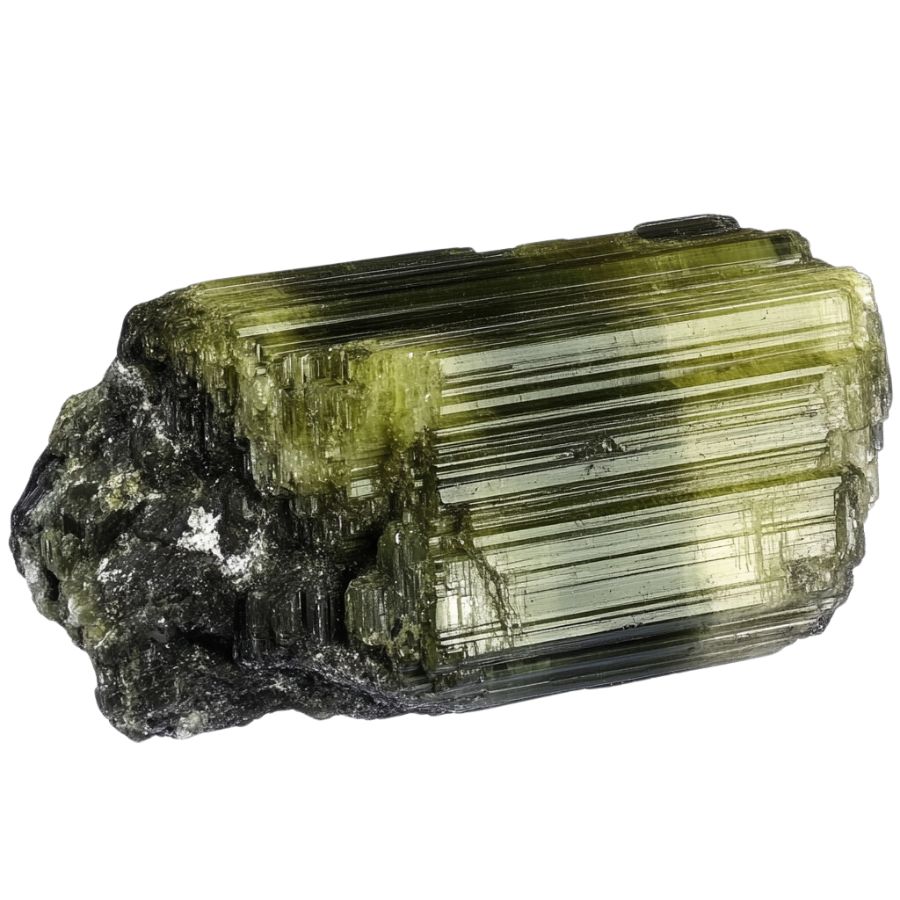
Cat’s eye tourmaline is known for its mesmerizing chatoyancy effect. This creates a bright band across the stone’s surface, resembling a cat’s eye.
This stone comes in various colors, from green to pink to brown, and is usually semi-translucent to opaque.
What makes this stone special is the perfect alignment of tiny, needle-like inclusions inside it. These scatter light in a unique way, creating that eye-catching effect. It’s quite different from other tourmalines that don’t have this feature.
Unlike other cat’s eye stones, Tourmaline offers a wider range of colors and is often more affordable.
Achroite

Achroite is a rare, colorless variety of tourmaline that looks like a drop of clear water turned to stone. It’s completely transparent, making it unique among tourmalines which usually have color. The name comes from Greek, meaning “without color.”
What’s special about achroite is that it doesn’t change color when viewed from different angles. It means the stone can be cut in many ways without losing its clarity.
Verdelite

Verdelite is known for its beautiful green color. It can range from light green to deep emerald.
One thing that makes verdelite special is that you can find big, clear crystals of it. This isn’t always easy with other gemstones.
People love using verdelite in jewelry because its rich color and interesting light effects make it a popular choice for all kinds of accessories. Each piece of verdelite is like a little piece of nature you can wear.
Paraíba Tourmaline

Paraíba Tourmaline is a rare gemstone that catches the eye with its vibrant neon blue or green color. It’s like no other tourmaline you’ve seen before. The intense glow comes from copper in the stone, making it stand out from its cousins.
This stone is one of the rarest. For every 10,000 diamonds mined, only one Paraíba tourmaline is found.
It was only discovered in the late 1980s, making it a newcomer in the gem world. But Paraíba tourmaline’s unique color and rarity quickly made it a favorite among gem lovers.
Its discovery caused quite a stir in the gem community. Even small stones can be valuable because of how rare and beautiful they are.
What Rough Tourmaline Looks Like
When you’re out looking for rough Tourmaline on your own it’s important to know what you’re looking for. But before we dive into specifically what to look for you need to make sure you understand the type of rocks and minerals you’re seeing.
DON'T MISS OUT ON ANY GREAT FINDS!
While you're out searching for Tourmaline you're going to find A LOT of other interesting rocks and minerals along the way. The last thing you want to do is toss out something really interesting or valuable. It can be easy to misidentify things without a little guidance.
We've put together a fantastic field guide that makes identifying 140 of the most interesting and valuable rocks and minerals you will find REALLY EASY. It's simple to use, really durable, and will allow you to identify just about any rock and mineral you come across. Make sure you bring it along on your hunt!
Now, back to the identification specifics:
Here are some tips to help you recognize rough tourmaline.
Look for Color Variations

Tourmaline comes in many colors, like pink, green, blue, and even black. Some pieces have multiple colors, like watermelon tourmaline, which is pink and green.
If you see these color mixes, it’s likely tourmaline. Keep an eye out for vibrant shades.
Assess the Density and Weight

Rough tourmaline is relatively heavy for its size. If you pick up a piece and it feels denser than expected, it could be tourmaline. This weight can help you confirm your find.
Examine the Crystal Structure

Tourmaline features distinctive crystal shapes, ranging from slender and elongated to chunky forms. Look for triangular cross-sections and striations on the surface, which indicate its unique growth patterns.
Check for Transparency

Some rough tourmaline can be slightly transparent. If you hold it up to the light, you might see through it a bit. This transparency can be a good sign that you have tourmaline.
A Quick Request About Collecting
Always Confirm Access and Collection Rules!
Before heading out to any of the locations on our list you need to confirm access requirements and collection rules for both public and private locations directly with the location. We haven’t personally verified every location and the access requirements and collection rules often change without notice.
Many of the locations we mention will not allow collecting but are still great places for those who love to find beautiful rocks and minerals in the wild without keeping them. We also can’t guarantee you will find anything in these locations since they are constantly changing.
Always get updated information directly from the source ahead of time to ensure responsible rockhounding. If you want even more current options it’s always a good idea to contact local rock and mineral clubs and groups
Tips on where to look
Once you get to the places we have listed below there are some things you should keep in mind when you’re searching:
Look for Sedimentary Rocks

Sedimentary rocks are great places to find tourmaline. These rocks form from layers of sand, mud, and minerals. Over time, minerals like tourmaline can get trapped.
Look in riverbeds or areas where sediment has built up. You might find small pieces or even larger crystals.
Explore Mines
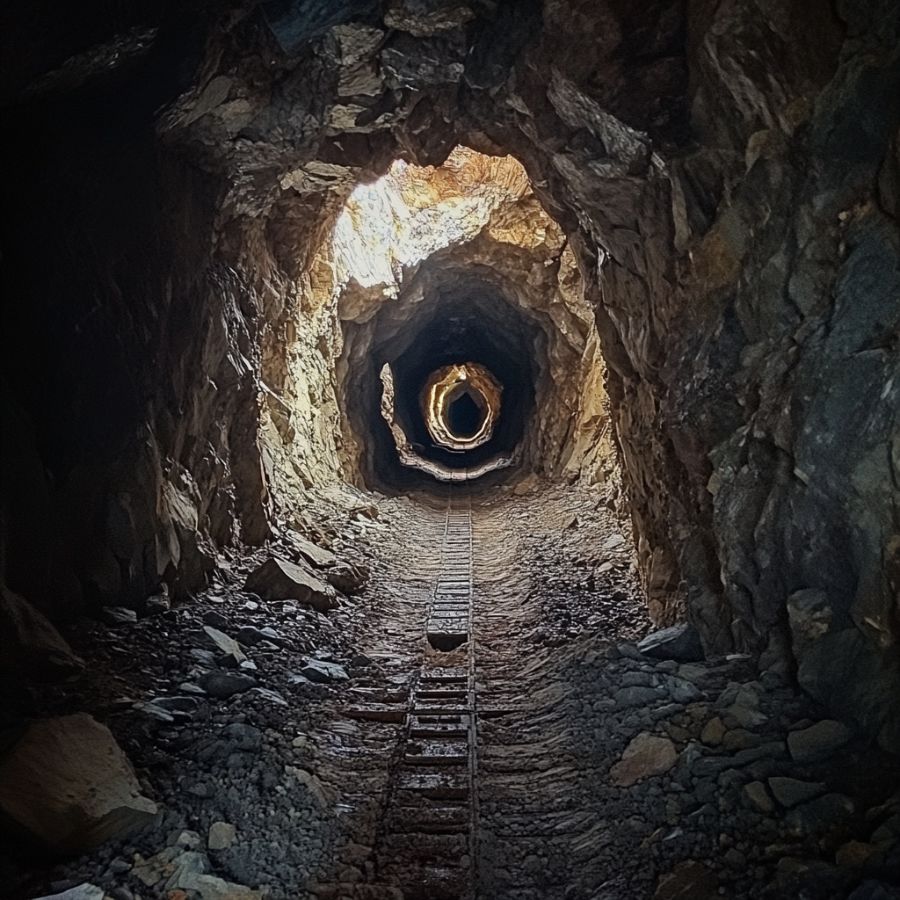
Mines are great spots to find tourmaline. Many mines across the U.S. extract various gemstones, including tourmaline.
Some mines even allow visitors to search for gems themselves. Always check if they have guided tours or special digging days.
Search in Gravel Pits

Gravel pits are often overlooked, but they can be treasure troves. These pits dig deep into the earth, exposing layers of rock.
Tourmaline can be found in the gravel. Just sift through the material carefully.
The types of Tourmaline can you find around the state
New Mexico is home to several fascinating types of tourmaline, particularly green tourmaline and watermelon tourmaline.
Green tourmaline, also known as verdelite, can vary in shade from light to deep green due to the presence of iron and titanium in its composition. This variety is often found in metamorphic rocks, where it forms beautiful, elongated crystals.
Watermelon tourmaline is a unique and striking variety that features a pink center surrounded by a green outer layer, resembling the colors of a watermelon.
This stunning gem is part of the elbaite group of tourmalines and is prized for its natural color zoning.
Some Great Places To Start
Here are some of the best places to start looking for tourmalines in New Mexico:
Always Confirm Access and Collection Rules!
Before heading out to any of the locations on our list you need to confirm access requirements and collection rules for both public and private locations directly with the location. We haven’t personally verified every location and the access requirements and collection rules often change without notice.
Many of the locations we mention will not allow collecting but are still great places for those who love to find beautiful rocks and minerals in the wild without keeping them. We also can’t guarantee you will find anything in these locations since they are constantly changing.
Always get updated information directly from the source ahead of time to ensure responsible rockhounding. If you want even more current options it’s always a good idea to contact local rock and mineral clubs and groups
Los Pinos Mountains

The Los Pinos Mountains are a small mountain range located in the central part of New Mexico. It runs slightly west of south for about 15 miles and is situated near the Rio Grande Valley.
Its western ridge exposes ancient Precambrian rock, a prime spot for tourmaline hunters. The eastern and southern parts showcase cuestas with preserved Paleozoic sedimentary beds, adding to the area’s mineral diversity.
Whiteface Mountain, the highest peak at 7,530 feet, stands as a landmark for explorers.
The mountains’ steep western face, formed by a normal fault, contrasts with the eastern limits shaped by thrust faulting. This unique geology creates ideal conditions for tourmaline formation.
For the best tourmaline finds, head to the western ridge where erosion has revealed ancient Precambrian rocks. Hiking trails in this area offer access to potential tourmaline deposits, making your search both adventurous and rewarding.
Santa Fe Range
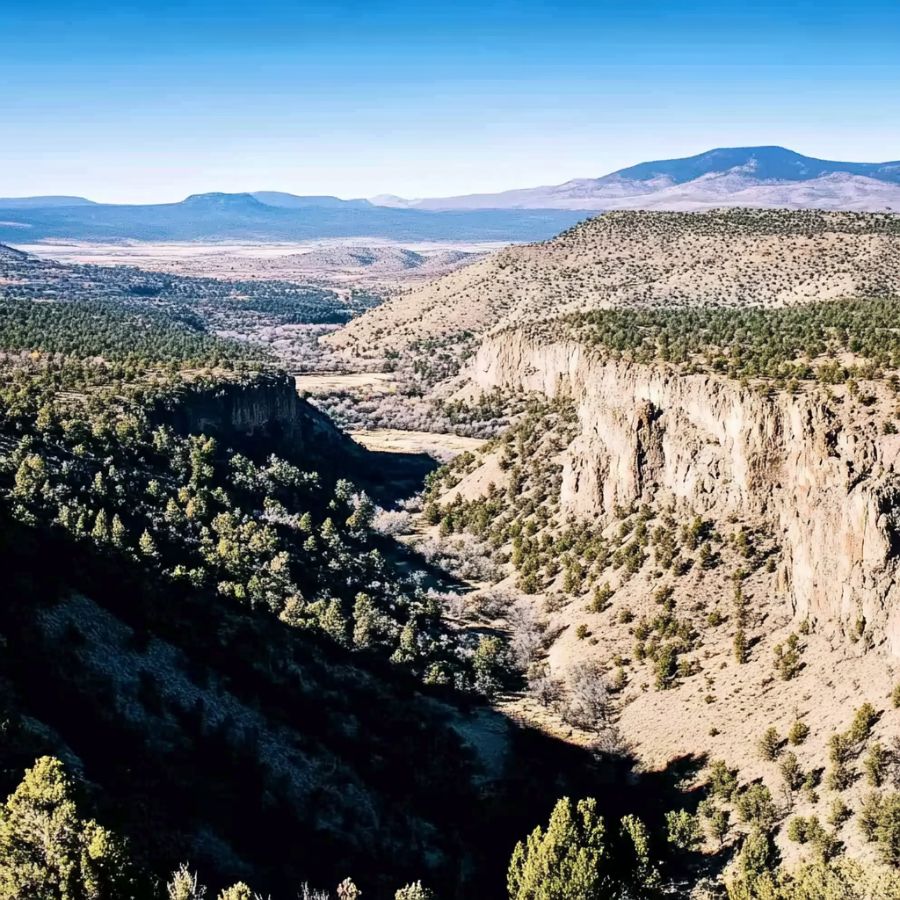
The Santa Fe Range is part of the Sangre de Cristo Mountains, located in the northern part of New Mexico. This range is characterized by its mountainous terrain and is situated to the east of the city of Santa Fe.
This ancient mountain range boasts some of the oldest rocks in the region, dating back over a billion years. The area’s rich geological history, shaped by multiple mountain-building events, makes it a prime spot for tourmaline hunting.
Rockhounds flock to the Santa Fe Range for its unique Proterozoic basement rocks. These ancient formations house pegmatite veins, where tourmaline crystals often hide.
Look for these veins in the range’s prevalent metavolcanic and metasedimentary rocks. The area’s complex geological structure, a result of its turbulent past, creates ideal conditions for mineral formation.
Costilla Area

The Costilla area is located in the northern part of Taos County, New Mexico, near the Colorado border. It features a variety of landscapes, including the Costilla massif, a 14-mile long ridge of granite and metamorphic rocks.
The area’s warm-summer humid continental climate has shaped its unique geological features over time. Tourmaline has been discovered in this rocky wonderland.
The diverse landscape of the Costilla massif offers a perfect playground for gemstone enthusiasts.
As you explore the granite and metamorphic formations, keep your eyes peeled for the distinctive prismatic crystals of tourmaline. The rich geological diversity of this area not only makes it a prime spot for finding tourmaline but also adds to its scenic beauty.
Manzano Mountains
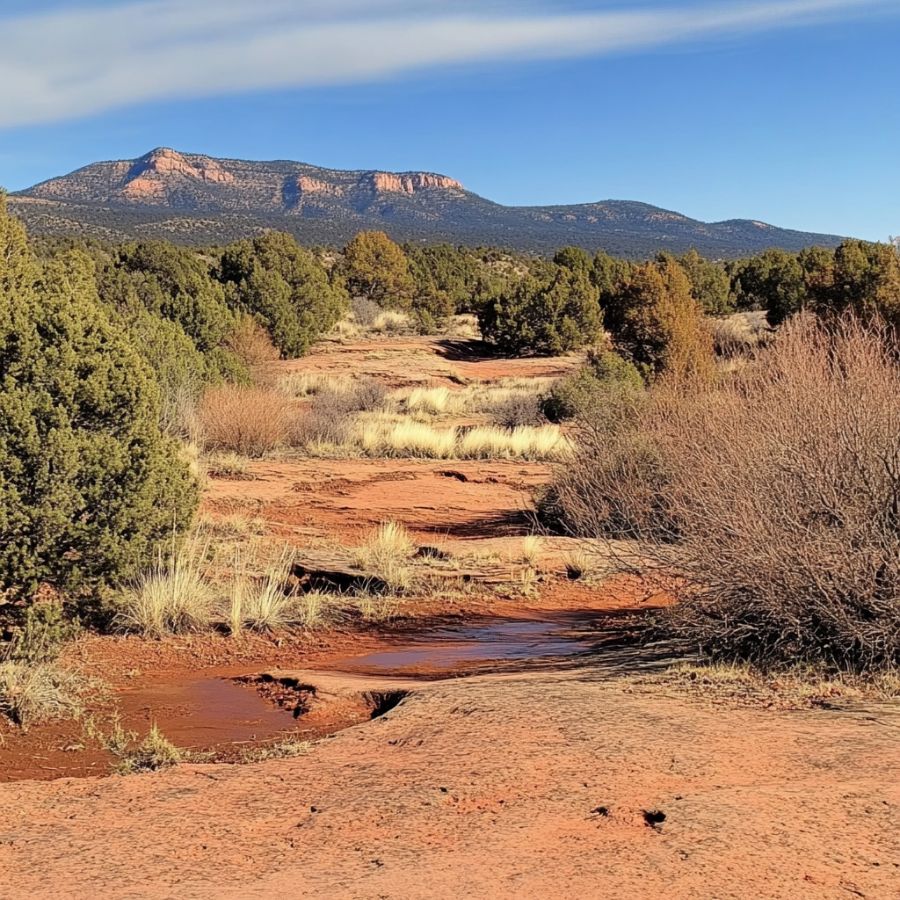
The Manzano Mountains is a small range stretching about 30 miles north-south in central New Mexico. Located east of Belen, these mountains are part of the Sandia-Manzano geologic unit, known for its diverse mineral deposits.
The range’s unique geology, featuring Paleozoic sedimentary and Proterozoic metamorphic rocks, creates an ideal environment for gemstone formation.
Tourmaline seekers should focus on the western slopes and crest, where metamorphic rocks are abundant. These areas often contain pockets where tourmaline crystals form.
The mountains’ east-tilted fault-block structure, part of the Rio Grande rift’s eastern edge, contributes to the variety of minerals found here.
Besides tourmaline, rockhounds might stumble upon other interesting specimens in this geologically diverse terrain.
The Manzano Mountains also offer scenic hiking trails, making gem hunting an enjoyable outdoor adventure in this picturesque New Mexican landscape.
Embudo Canyon
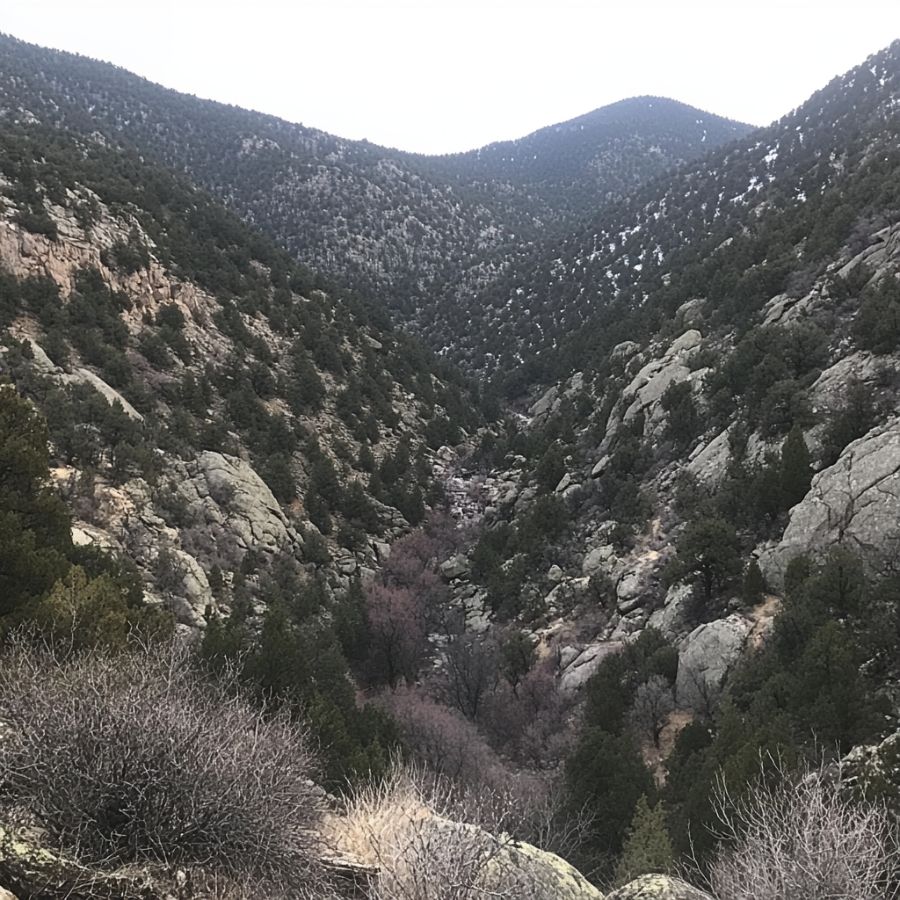
Embudo Canyon is a scenic area located in the Sandia Mountains, within Bernalillo County. It is situated near Albuquerque, in the central part of the state.
The canyon’s unique landscape of granite and schist outcrops tells a story of ancient geological activity, creating an ideal environment for mineral formation.
Tourmaline hunters should focus their search near the base of canyon walls and in areas where erosion has exposed underlying rock layers. The canyon’s numerous boulders and rocky outcrops provide excellent opportunities for discovery.
While exploring, keep an eye out for the distinctive prismatic crystals of tourmaline, which can range in color from black to pink.
Places Tourmaline has been found by county
After discussing our top picks, we wanted to discuss the other places on our list. Below is a list of the additional locations where we have succeeded, along with a breakdown of each place by county.
| County | Location |
| Bernalillo | Juan Tabo area |
| Cibola | Zuni Mountains |
| Doña Ana County | Organ Mountains |
| Grant | Wake-Up-Charlie Mine |
| Guadalupe | Puerto de Luna area |
| Guadalupe | Santa Rosa area |
| Hidalgo | Virginia District in Lordsburg |
| Hidalgo | Gold Hill Mine |
| Hidalgo | Battleship Mine |
| Lincoln | Barry prospect |
| Lincoln | Drunzer prospect |
| Lincoln | King prospect |
| Lincoln | McCrory Prospect Sec 36 |
| McKinley | Fort Defiance area |
| Mora | Pidlite deposit |
| Rio Arriba | Unnamed prospects on Kiawa Mountain |
| Rio Arriba | El Fidel Beryl Deposit |
| Rio Arriba | Hidden Treasure group in Hopewell District |
| Rio Arriba | Canary Bird Pegmatite |
| San Juan | Nelson Point Mine |
| San Miguel | Elk Mountain deposit |
| San Miguel | Guy no. 1 deposit |
| Sandoval | Cochiti District |
| Santa Fe | Cerrillos District |
| Santa Fe | Carache Canyon breccia in Old Placers District |
| Santa Fe | Swan tunnel |
| Socorro | Magdalena Mining District |
| Toas | Picuris District |
| Toas | Copper Hill deposits |
| Toas | Red River Mining District |
| Toas | Twining District |
| Torrance | Negra Area |


